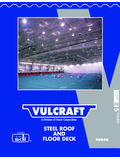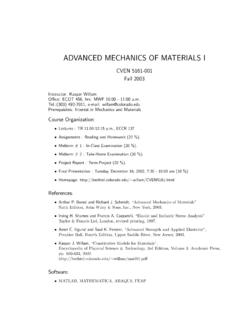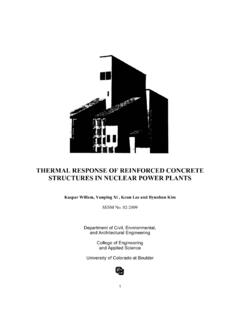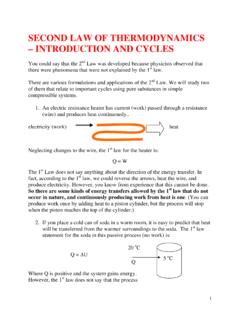Transcription of Strategies for overlapping dependent design …
1 Strategies for overlapping dependent design activitiesSUSAN M. BOGUS1*, KEITH R. MOLENAAR2and JAMES E. DIEKMANN21 Department of Civil Engineering, University of New Mexico, Albuquerque, NM 87131, USA2 Department of Civil, Environmental and Architectural Engineering, Campus Box 428, University of Colorado,Boulder, CO 80309, USAR eceived 6 March 2005; accepted 27 February 2006 overlapping activities that are traditionally performed in a sequential manner can significantly reduce projectdelivery times. overlapping , however, should be approached in a systematic manner to reduce the costs andrisks. Information gathered from sector-based case studies and from the manufacturing domain suggest aformalised framework for identifying overlapping opportunities and Strategies can be successfully implementedfor infrastructure projects.
2 This framework considers activity characteristics, such as evolution of upstreaminformation and sensitivity of downstream activities to changes in upstream information, to identify appropriateoverlapping Strategies . overlapping Strategies , such as early freezing of design criteria, overdesign, and earlyrelease of preliminary information, are selected based on activity characteristics. These Strategies operate eitherby speeding up the evolution of upstream information or by reducing the sensitivity of downstream activities . Byaligning overlapping Strategies with activity characteristics, project managers can make better decisions on whenand how much to overlap sequential activities to reduce overall project delivery :Concurrent engineering, project management, decision makingIntroductionThe design and construction of large projects is acomplex process.
3 Rarely is the same design used formultiple projects, which results in a series of one-offdesigns. From a project management perspective, thedesign planning process involves bringing togethernumerous pieces of information from multipledesigners to form the final design . Coordinating theflow of information in the design process is furthercomplicated when the design schedule needs to fundamental strategy for reducing project deliverytimes calls for overlapping dependent degree to which dependent design activities maybe overlapped is defined by the nature of the informa-tion exchange between those activities . Concurrentengineering literature (Krishnanet al.)
4 , 1997, Loch andTerwiesch, 1998) describes this information exchangebetween an upstream task and a downstream taskin terms of the evolution of information developmentin each task and the sensitivity of the downstream taskto changes in upstream dependent activities requires that workon the downstream activity starts before the requiredupstream information is finalised. Therefore, thedownstream activity must begin with incomplete,non-optimal, or non-final information. The extent towhich the information is likely to change is a function ofthe evolution of the upstream activity. The faster theevolution of the upstream activity, the less likely it isthat upstream information will substantially sensitivity of the downstream activity describes theextent to which changes in upstream information createrework in the downstream activity.
5 overlapping twodependent activities requires that either upstreaminformation be passed downstream sooner ( speedup evolution) or downstream activities reduce theirsensitivity to changes in upstream information. Themanner in which this process occurs is referred to as anoverlapping primary objective of this research was todetermine how to apply Strategies to increase theoverlap between dependent design activities . Inherentin this issue are several sub-questions such as: (1)*Author for correspondence. E-mail: Management and Economics(August 2006)24, 829 837 Construction Management and EconomicsISSN 0144-6193 print/ISSN 1466-433X online#2006 Taylor & : Strategies are available for overlapping sequen-tial design activities ?
6 (2) Which of the identifiedstrategies are appropriate based on evolution andsensitivity characteristics? and (3) What are the con-sequences of applying these Strategies to overlapsequential design activities ? overlapping of design tasks is not without risksor costs. Some of the risks and costs associatedwith overlapping , and more generally fast-trackconstruction, include lack of design optimisation andcoordination, increased levels of rework due to trans-fer of insufficient design information, increasedmaterials wastage, inadequate coordination betweendesign and construction, and inadequate scheduling ofthe work package interfaces (Fazioet al.)
7 , 1988;Williams, 1995). Because of the increased risk asso-ciated with overlapping of design , a formalisedapproach is necessary to reduce potential the seminal work by Krishnanet al.(1997), overlapping Strategies were identified based on theevolution of information in the upstream activity andthe sensitivity of the downstream activity to changes inupstream information. The best environment for over-lapping occurs when the upstream activity is fastevolving and the downstream activity has low sensitiv-ity. According to Krishnanet al., evolution andsensitivity characteristics provide a framework forclassifying the strength of the information dependenciesbetween the Krishnanet , if there is slowevolution and low sensitivity then overlapping throughthe exchange of preliminary design information isrecommended (referred to as iterative overlapping ).
8 Ifevolution is fast and sensitivity is low, then bothexchange of preliminary design information and earlyfinalisation of the upstream design information arerecommended (referred to as distributive overlapping ).Highly sensitive activities with slow evolution are theleast likely to benefit from overlapping and should bedecomposed to sub- activities , if possible (referred to asdivisive overlapping ). Highly sensitive activities withfast evolution are best overlapped by early finalisationof upstream information (referred to as pre-emptiveoverlapping) (Krishnanet al., 1995; Krishnan, 1996;Krishnanet al., 1997).By understanding the relationship between twodependent activities in terms of evolution and sensitiv-ity, a project manager can use that information toidentify appropriate Strategies for overlapping theactivities.
9 This paper presents the results of a studythat aligns multiple overlapping Strategies to theevolution and sensitivity characteristics of recommended by Krishnanet al.(1997), the initialwork in this study used interview data from designprofessionals to develop the framework for characteris-ing design activities in terms of evolution and sensitiv-ity. The research methodology employed sector-basedcase studies to collect and organise activity character-isation information from exploratory interviews withdesign professionals. The case studies covered threesectors in the architecture, engineering and construc-tion (AEC) industry roadway design , water/waste-water treatment plant design , and mechanical andelectrical design for building systems.
10 Case studyprotocols were used to design and validate the research(Merriam, 1988; Yin, 1994; Stake, 1995).A total of 16 exploratory interviews were conductedas part of the sector-based case studies. The intervieweegroup included design professionals from both publicand private organisations, who were generally at aproject manager level or above. Most interviewees had10 years of experience or more. The interview formatwas semi-structured, which is appropriate for explora-tory interviews. That means that there were no fixedquestions, but rather, the interviewer had a general listof topics that were used to guide the interview(Oppenheim, 1992). The initial list of topics wasderived from the research questions and the back-ground literature review.










